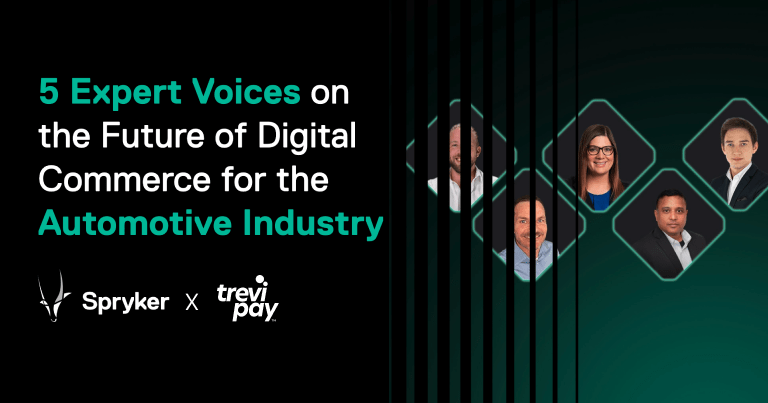Meet Spryker’s Felix Buehner
Felix Buehner is the Global Lead for Automotive and Mobility at Spryker, a leading eCommerce platform provider based in Berlin, Germany. With over five years of experience in the automotive and technology industries, Felix is a recognized expert in digital transformation and eCommerce solutions for the automotive industry.
Felix started his career in the automotive industry working for Salesforce in Germany, where he gained experience in various areas such as sales, marketing and after sales processes, focusing on digital transformation and eCommerce strategies for automotive clients.
At Spryker, Felix is responsible for driving the company’s global automotive and mobility strategy, developing innovative solutions to help automotive businesses adapt to the rapidly changing digital landscape. He is a frequent speaker and thought leader on topics related to eCommerce, digital transformation and the future of mobility.
TreviPay talked with Felix to learn about what’s on the minds of those in the automotive industry.
1. AI is a hot topic
How is AI impacting the automotive industry? And what are the positive or not-so-positive outcomes?
AI is revolutionizing the automotive industry, primarily through autonomous driving technology, predictive maintenance and advanced driver assistance systems (ADAS). Positive outcomes include increased safety, reduced traffic congestion and personalized in-car experiences. However, concerns arise regarding job displacement, the ethics of decision-making in autonomous modes and potential vulnerabilities to hacking or system failures.
AI offers significant business potential in automotive after-sales and services. Predictive maintenance algorithms can forecast part failures, allowing for proactive replacements and reducing downtimes. Natural language processing (NLP) tools enhance customer service, addressing inquiries and complaints efficiently. Chatbots can assist in scheduling services, while AI-driven analytics help dealerships personalize offers, optimize inventory and improve service recommendations. Enhanced diagnostics using AI can quickly identify and rectify issues, saving time and ensuring customer satisfaction. Overall, AI promises increased revenue streams, deeper customer engagement and operational efficiency in after-sales and services.
2. Do you see any differences between different geographies when it comes to digital commerce (for example between North America, Europe and Asia)?
And are there any best practices from any of those geographies to leverage across others?
Certainly, the adoption and implementation of digital commerce in the automotive industry vary across geographies due to cultural, economic and technological differences:
North America
- Trends: There’s a growing acceptance of buying vehicles online, supported by platforms that offer 360-degree vehicle views, virtual test drives and online financing
- Challenges: Dealership laws in some states prevent direct online sales, necessitating innovative solutions to blend online and offline experiences
- Emerging Trends: Integrative platforms that merge online shopping with offline test drives or vehicle pick-ups are popular. Subscription-based models for cars are also being experimented with
Europe
- Trends: Digital sales for electric vehicle (EV) sales are strong. Green initiatives drive online platforms that highlight eco-friendly vehicles
- Challenges: Diverse languages and regulations can make continent-wide platforms complex
- Emerging Trends: Digital platforms focusing on sustainability, leasing options and second-hand certified vehicle sales are emerging. Some manufacturers offer direct online sales.
Asia
- Trends: In markets like China, digital commerce is highly advanced. Mobile payments and Superapps make the transition from choosing a car to purchasing it seamless
- Challenges: Diverse markets from highly advanced (Japan, South Korea) to emerging (India, Southeast Asia) mean varied digital readiness
- Emerging Trends: Integrating automotive sales within larger eCommerce platforms, leveraging social media influencers for sales and introducing AR/VR (Augmented/Virtual Reality) showrooms are noteworthy
Leveraging Best Practices:
- The Asian model of blending eCommerce, entertainment and automotive purchasing can be considered for other markets to engage younger buyers.
- Europe’s emphasis on sustainability can be adapted worldwide, especially in light of global pushes toward eco-friendly transportation options.
- North America’s attempts to bridge online and offline through integrative platforms can be effective in markets with strong dealership structures.
However, any best practice transfer should consider the local cultural, regulatory and economic contexts.
3. What companies in the automotive industry do you see as a front-runner when it comes to digital commerce?
And what are they doing that can be adapted across the industry?
Several companies in the automotive industry are front-runners in digital commerce. Here are some standout examples:
Tesla:
- Visionary Moves: Tesla has bypassed the traditional dealership model entirely, selling cars directly to consumers online.
- Adaptability: The direct-to-consumer (DTC) sales model challenges traditional dealerships, prompting a rethink of the car-buying experience
BMW:
- Visionary Moves: Through its “Retail Online” service, BMW allows customers to configure, order and finance cars online. They’ve integrated augmented reality (AR) features, offering virtual tours of vehicles.
- Adaptability: The fusion of online configurators with AR can enhance the buying experience, a model that could be replicated across brands.
Daimler (Mercedes-Benz Passenger Cars):
- Visionary Moves: They have invested significantly in digital touchpoints and eCommerce solutions. Their online showroom offers virtual consultations and vehicle walkarounds.
- Adaptability: Personalized digital consultations and digital showrooms could become the norm in luxury car sales.
Alibaba & SAIC Motor Corporation:
- Visionary Moves: Together, they launched the “Auto Vending Machine” in China, where customers can select a car online, pick it up for a test drive and potentially purchase, all without human interaction.
- Adaptability: The unattended showroom and sales experience, especially for test drives, can be adapted in markets where consumers desire convenience and minimal human interaction.
Volvo:
- Visionary Moves: With the “Care by Volvo” subscription service, they’ve introduced an alternative to buying or leasing. This all-inclusive service can be entirely managed online.
- Adaptability: Subscription models, blending aspects of leasing and ownership, could appeal to younger consumers and those seeking flexibility.
While these companies are pioneering digital commerce within the automotive sector, the core of success lies in understanding customer needs and leveraging technology to provide seamless, convenient and efficient buying experiences. These strategies, when tailored to specific markets and consumer segments, have the potential to reshape the automotive sales landscape globally.
4. What additional challenges are in the B2B space when it comes to digital commerce?
Digital commerce in the B2B space has unique challenges when compared to the B2C sector, primarily due to the complexity of transactions, products and relationships. Some of these challenges include:
- Complex Sales Cycles: B2B purchases often involve multiple decision-makers, stages of approval and longer sales cycles, making the digitization of the entire process intricate.
- Product Complexity: B2B products can be highly specialized, requiring detailed product information, specifications and customized solutions.
- Price Negotiation: Unlike fixed pricing in most B2C scenarios, B2B often involves negotiation, bulk discounts and contractual agreements, which can be challenging to handle on digital platforms.
- Integration with Legacy Systems: Many B2B companies have been in operation for decades and might rely on older IT infrastructures. Integrating these with new eCommerce solutions can be technically and financially challenging.
- Regulatory and Compliance Issues: B2B transactions, especially in sectors like healthcare, finance or aerospace, might be subject to strict regulations, which need to be incorporated into the digital buying journey.
- Customized Payment Terms: Unlike the straightforward payment methods in B2C, B2B might involve credit terms, installment plans, and PO (Purchase Order) processes.
- Supply Chain Integration: B2B eCommerce often requires real-time integration with supply chain systems to provide accurate delivery timelines, inventory levels and production schedules.
- Educational Needs: B2B buyers require extensive knowledge about products before purchase. Providing this digitally through videos, whitepapers and webinars can be time and resource-intensive.
- Relationship Management: B2B relies heavily on relationship-based selling. Replicating the trust and personal touch of face-to-face interactions on a digital platform is challenging.
- Security Concerns: Given the scale of transactions and the sensitivity of business information, B2B digital platforms need robust security measures against potential cyber threats.
To overcome these challenges, B2B organizations often need to invest in sophisticated digital commerce platforms, integrate advanced customer relationship management (CRM) tools and continuously iterate their online strategies based on feedback and evolving market conditions.
A best practice is to follow a best-of-breed approach instead of a best-of-suite approach, as the complexity within these different platforms is better covered with specialized solutions for commerce, CRM, CPQ and others.
Ready to learn more about the challenges the automotive industry faces?
Check out Spryker’s “5 Expert Voices on the Future of Digital Commerce for the Automotive Industry”






